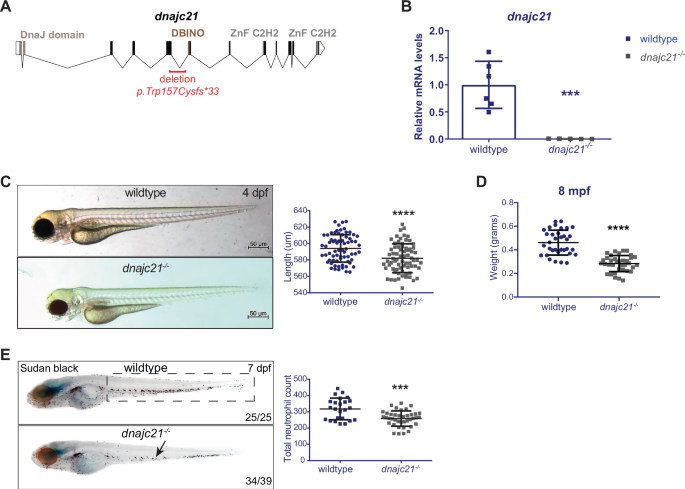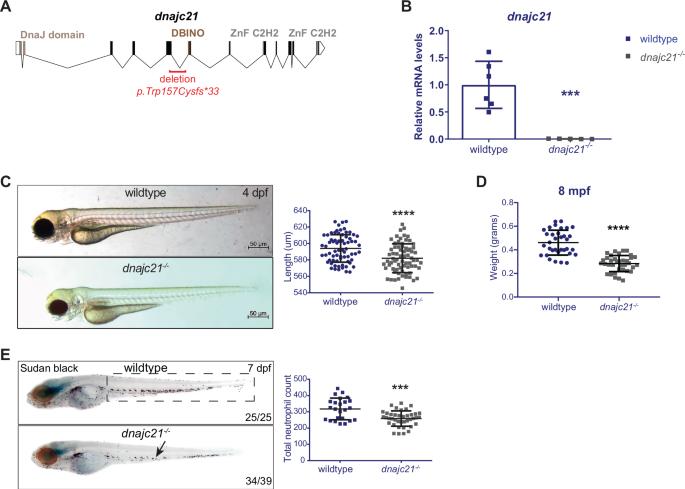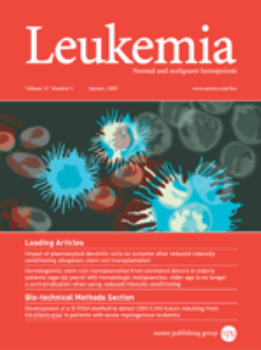Dnajc21 缺失导致斑马鱼细胞减少和核苷酸代谢改变
IF 12.8
1区 医学
Q1 HEMATOLOGY
引用次数: 0
摘要
DNAJC21 基因突变最近在 Shwachman-Diamond 综合征(SDS)中被描述出来,SDS 是一种骨髓衰竭综合征,极易诱发骨髓恶性肿瘤。为了研究造血调节和疾病的生物学基础,我们利用斑马鱼建立了首个 Dnajc21 缺乏症的体内模型。斑马鱼 dnajc21 突变体表现出 SDS 患者的主要表型,如全细胞减少、生长减弱和蛋白质合成缺陷。我们发现,细胞减少症是造血分化受损、DNA 损伤积累和细胞增殖减少的结果。在 dnajc21 突变体中引入一个双偶性 tp53 突变会导致骨髓增生异常性肿瘤样特征的发展,其特征是红细胞形态异常和造血祖细胞扩增。通过转录组和代谢组分析,我们发现了 Dnajc21 在核苷酸代谢中的新作用。补充外源性核苷可恢复中性粒细胞数量,这揭示了核苷酸失衡与中性粒细胞分化之间的关联,表明了 dnajc21 突变体 SDS 生物学中的一种新机制。本文章由计算机程序翻译,如有差异,请以英文原文为准。


Loss of Dnajc21 leads to cytopenia and altered nucleotide metabolism in zebrafish
Mutations in the DNAJC21 gene were recently described in Shwachman–Diamond syndrome (SDS), a bone marrow failure syndrome with high predisposition for myeloid malignancies. To study the underlying biology in hematopoiesis regulation and disease, we generated the first in vivo model of Dnajc21 deficiency using the zebrafish. Zebrafish dnajc21 mutants phenocopy key SDS patient phenotypes such as cytopenia, reduced growth, and defective protein synthesis. We show that cytopenia results from impaired hematopoietic differentiation, accumulation of DNA damage, and reduced cell proliferation. The introduction of a biallelic tp53 mutation in the dnajc21 mutants leads to the development of myelodysplastic neoplasia-like features defined by abnormal erythroid morphology and expansion of hematopoietic progenitors. Using transcriptomic and metabolomic analyses, we uncover a novel role for Dnajc21 in nucleotide metabolism. Exogenous nucleoside supplementation restores neutrophil counts, revealing an association between nucleotide imbalance and neutrophil differentiation, suggesting a novel mechanism in dnajc21-mutant SDS biology.
求助全文
通过发布文献求助,成功后即可免费获取论文全文。
去求助
来源期刊

Leukemia
医学-血液学
CiteScore
18.10
自引率
3.50%
发文量
270
审稿时长
3-6 weeks
期刊介绍:
Title: Leukemia
Journal Overview:
Publishes high-quality, peer-reviewed research
Covers all aspects of research and treatment of leukemia and allied diseases
Includes studies of normal hemopoiesis due to comparative relevance
Topics of Interest:
Oncogenes
Growth factors
Stem cells
Leukemia genomics
Cell cycle
Signal transduction
Molecular targets for therapy
And more
Content Types:
Original research articles
Reviews
Letters
Correspondence
Comments elaborating on significant advances and covering topical issues
 求助内容:
求助内容: 应助结果提醒方式:
应助结果提醒方式:


